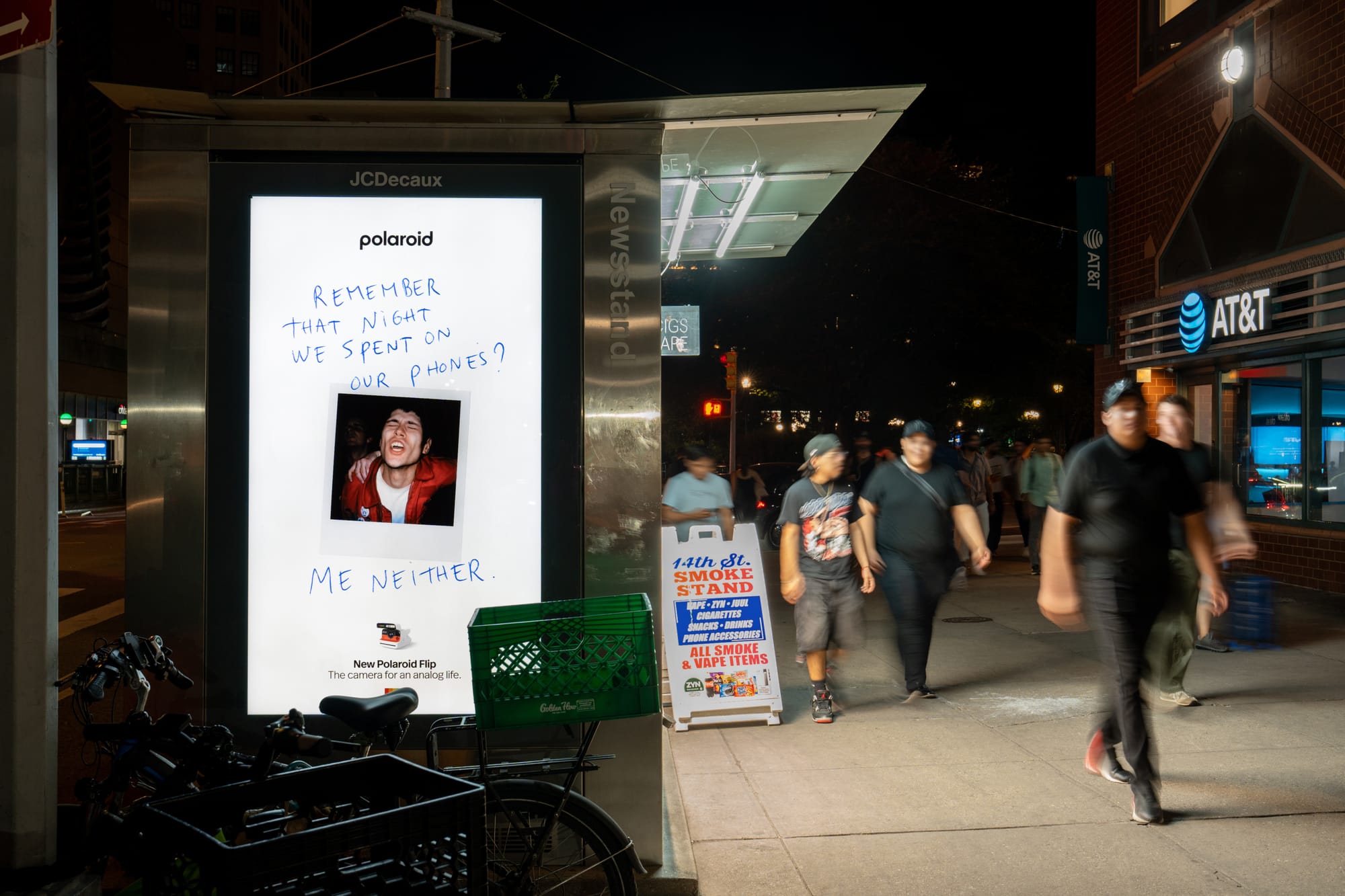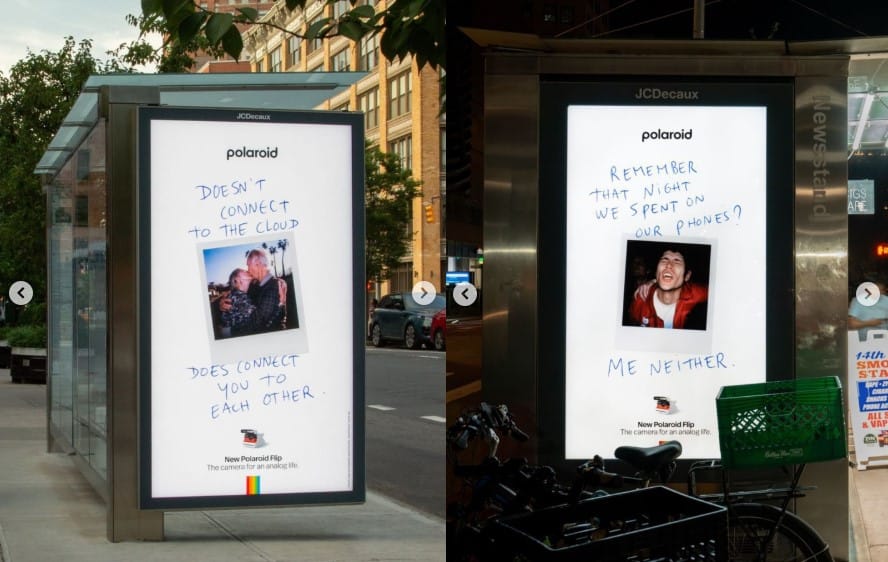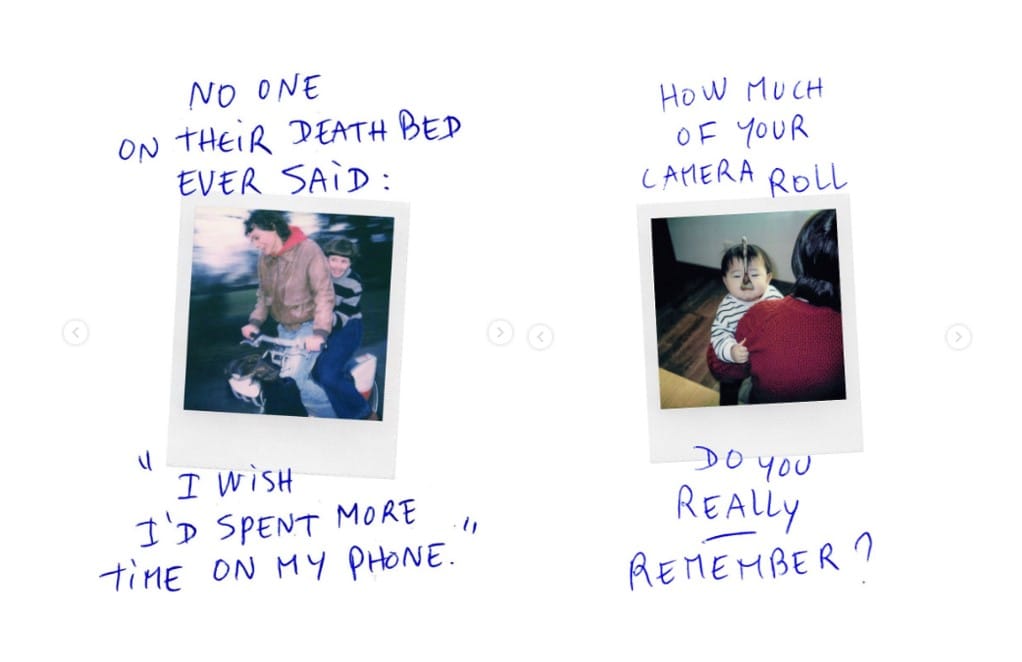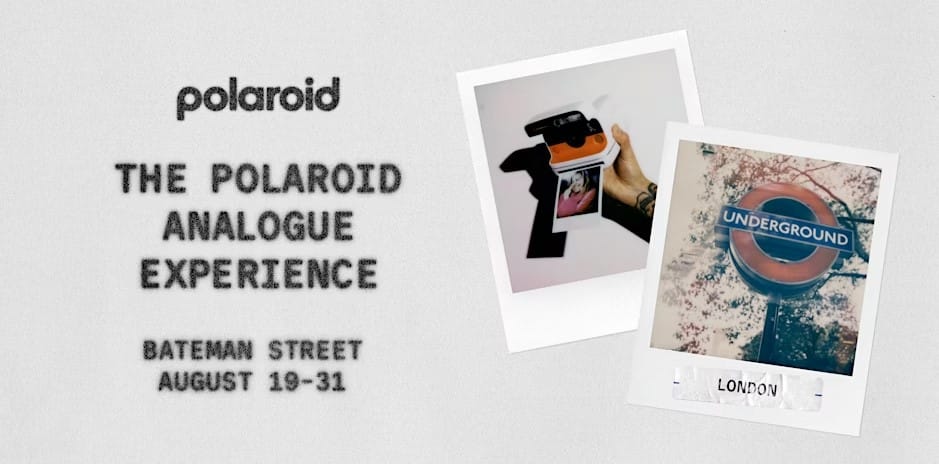Real life in focus: why Polaroid’s Flip campaign strikes home

Les points-clés en français au bas de l'article
“AI can’t generate sand between your toes.” That’s the line that made me fall in love with Polaroid’s latest campaign for its new camera, the Flip. But there’s more to admire beyond just that sentence. What makes this campaign so compelling is how it taps into something many of us quietly crave: the tangible, imperfect, and fleeting nature of real life – something digital experiences often flatten or filter away.
Polaroid pictures are, in many ways, the perfect antidote to digital overload. This campaign captures that by immersing us in real-life moments through a series of images – some full-bleed, others framed unmistakably as Polaroids – and by highlighting 4 key ideas:
- Physical, singular objects
Polaroid pictures are objects you can hold, cherish, scribble on with a biro pen, or even tear apart. Whatever you do with them, that physical contact creates an emotional connection that will never exist through a screen.
That emotional value is heightened by the fact that there’s no negative, no endless digital copies unless you choose to make them. If you lose a Polaroid, it’s gone forever. That lack of replication gives it weight – emotional value and permanence in a world obsessed with disposable content.
The materiality of a Polaroid reminds us that humans too are physical beings, bodies meant to feel the texture of the world. Analog objects help us reconnect with that essential, bodily reality, pulling us away from the frictionless smoothness of screens and back into three dimensions.
In the campaign:
Physicality is conveyed not just through the mention of “sand between your toes” but also through handwritten captions in ballpoint ink and the use of faded, time-worn colors.

- Moments over content
In an age of polished selfies and AI-generated imagery – where results matter more than experiences, and the goal is to stage the perfect shot rather than live the moment – Polaroids act as quiet resistance.
Polaroid pictures aren’t about perfection; they’re about presence. The images are secondary to the moments they capture. They exist as triggers for memory and emotion, not as content to be curated. The campaign gently reminds us: not every moment needs to be shared. Some moments are just for us.
In the campaign:
The images highlight genuine, messy, beautiful moments – kissing, resting with your newborn, fooling around on a moped, partying hard. These photos only exist because something real happened. They’re by-products of lived experience, not the goal itself.
This ties into the idea of “anti-aesthetics”, i.e. the refusal to play the algorithm’s game of optimization and perfection, defined in this video.

- The magic of uncertainty and imperfection
Prioritizing moments over deliverables inevitably invites uncertainty and imperfection. There’s magic in not knowing exactly how a photo will turn out. That unpredictability mirrors life itself: imperfect, unexpected, and all the more beautiful for it.
In the campaign:
The visuals – skewed angles, motion blur, imperfect framing – capture this spirit.Some images, like a child in a mother’s arms or kids laughing on a moped, echo the work of Dutch artist Erik Kessels on vernacular photography, which celebrates the beauty of amateur snapshots: intimate, spontaneous, and full of unplanned details. These are the moments we can’t stage or replicate – the ones that slip through our fingers even as we try to hold on.
"Every time you press the button of a Polaroid camera, it’s a little like playing roulette. It’s what sets us apart from competitors who offer reliable, predictable results. To a certain extent, uncertainty is our strength."
Oskar Smolokowski, Chairman of the Board

- Nostalgia for a pre-Internet life
A recent survey by the British Standards Institution found that nearly half of young people aged 16 to 21 would prefer to be young in a world without the internet. Half believe a social media curfew would improve their lives.
There was a time when living in the real world wasn’t a choice – it was the only option. Today, the longing for a pre-internet era – a time before everything was instantly documented, filtered, and shared – is real and growing.
In the campaign:
The faded colors, vintage aesthetic, the hairstyles, the fashion and even the name of the camera itself, Flip (like a flip phone), all evoke that pre-digital era, creating a comforting sense of nostalgia.

To sum up: an invitation to step back into the real world
Polaroid’s Flip campaign is more than a marketing exercise; it’s a quiet reflection on the two-dimensional lives many of us live through screens. It’s an invitation to take back power: to live fully, to reconnect with our bodies, with others and with the world around us.
And a very concrete invitation, with the Polaroid Analogue Experience, digital-free walking tours where participants lock up their phone and explore the city “through an analogue lens (on their analogue legs)” to learn the magic of instant.
The handwritten captions – those scrawled, spontaneous thoughts added to each Polaroid –serve as gentle reminders of what we know but so easily forget, for instance the fact that “No one on their deathbed ever said, ‘I wish I’d spent more time on my phone.’”
The campaign leaves us with this simple truth: life is happening now, in all its messy, imperfect, unpredictable glory. Don’t miss it.
-------------------------------------------------
Les points-clés en français:
- Pour le lancement du Flip, son dernier modèle, Polaroid a conçu une campagne sur une idée forte : le besoin de déconnexion, de plus en plus prégnant, et l'envie de se reconnecter physiquement aux autres et au monde qui nous entoure
- 4 notions-clés véhiculées par la campagne :
- la matérialité, des Polaroids eux-mêmes mais aussi des humains, dotés de corps physiques et capables de sentir "le sable entre leurs orteils", sable qu'une IA ne saura jamais générer
- la victoire de l'instant sur le contenu, avec des photos qui ne sont que le témoignage et la mémoire d'un moment, d'un événement et non conçues d'abord pour être partagées (l'anti-philosophie du livrable)
- la magie de l'incertitude et de l'imperfection, avec des photos un peu ratées mais/donc porteuses d'un charme et d'une charge émotionnelle incomparables
- la nostalgie d'une ère pré-internet où il était facile de vivre dans le vrai monde parce qu'il était le seul connu
- Une invitation à reprendre le pouvoir, à re-sentir son corps dans le monde et à renouer avec les humains qui nous entourent qui se vit aussi à travers la Polaroid Analogue Experience (visite guidée de la ville 100% sans écrans)